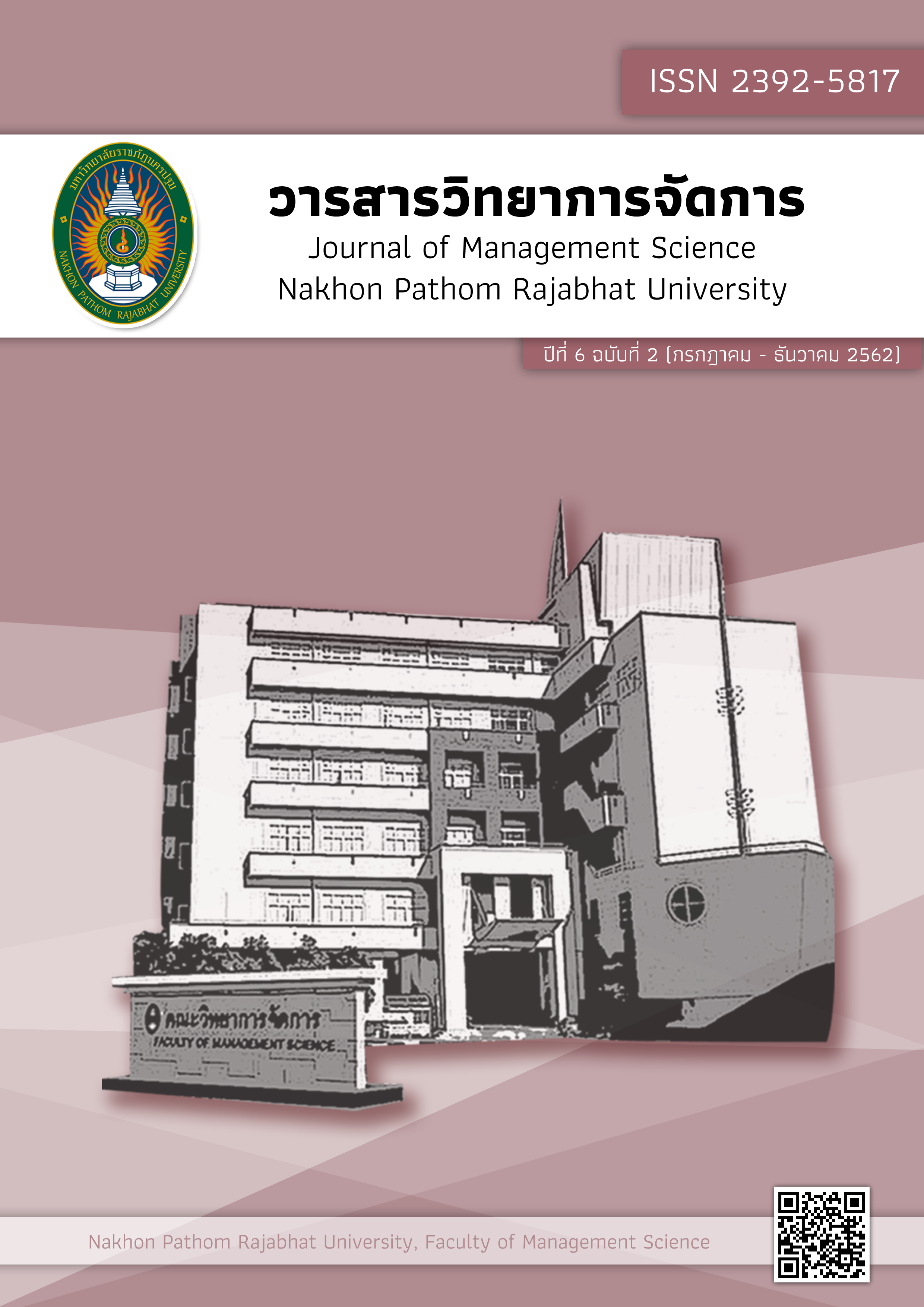The Development of Information System for Management in the Five Precepts Keeping Village Project at Nakhon Pathom Province
Main Article Content
Abstract
This research aims to 1) design and develop the Management Information System of the five precepts Nakhon Pathom Province and 2) evaluate the satisfaction of the using for the system. The system was developed in the form of web-based application and the SDLC (System Development Life Cycle) system was used for system design and development. The proposed system was evaluated the efficiency by 3 experts and was evaluated the satisfaction of using the system by 30 users, the staff of the Office of Buddhism in Nakhon Pathom and general users.
The study found that the results of the evaluation of the system from 3 experts by measuring performance in 4 areas: 1) system screen design 2) system performance 3) system processing and 4) system security. The average assessment results were in the high level, with an average of 4.42, standard deviation equal to 0.58.
The results of the satisfaction evaluation of the system usage from 30 users, with a total of 10 assessments: 1) Information is modern. 2) Information is accurate. 3) Information system covering all missions 4) Information system is beneficial to the operation 5) Information that meets the needs of users 6) Information systems in categories 7) Form and method of data presentation 8) The speed of finding information 9) Convenient access and 10) The system is easy to use. The average assessment results are in the high level, which is the average of 4. 5 standard deviations equal to 0.63.
Article history : Received 19 May 2019
Revised 11 June 2019
Accepted 13 June 2019
SIMILARITY INDEX = 2.82
Article Details
The views and opinions of the article appearing in this journal are those of the author. It is not considered a view and responsibility of the editorial staff.
References
กิตติ ภักดีวัฒนะกุล และจำลอง ครูอุตสาหะ. (2554). คัมภีร์ระบบฐานข้อมูล. กรุงเทพฯ : สำนักพิมพ์ไทยเจริญการพิมพ์.
กองกลางสำนักงานปลัดกระทรวงมหาดไทย. (2557). โครงการสร้างความปรองดองสมานฉันท์โดยใช้หลักธรรมทางพระพุทธศาสนา “หมู่บ้านศีล 5”. [ออนไลน์]. ค้นเมื่อ 1 กันยายน 2558 จาก https://www.gad.moi.go.th/nsv-17-07-57-1889.pdf
ดริณ จักรพันธุ์ อินทร์อุดม. (2555). การเผยแพร่พระพุทธศาสนาของพระสงค์ไทยผ่านสื่อใหม่: กรณีศึกษาเว็ปไซต์ธรรมะทูเดย์ดอทคอม. วิทยานิพนธ์ศิลปศาสตรมหาบัณฑิต สาขาวิชาการสื่อสารศึกษา มหาวิทยาลัยเชียงใหม่.
ธนันดา รังสิกุล. (2551). การนำเสนอองค์ประกอบ การออกแบบและเนื้อหาที่เหมาะสมของเว็บไซต์ สำนักงานปลัดกระทรวงศึกษาธิการ. การค้นคว้าแบบอิสระศึกษาศาสตรมหาบัณฑิต สาขาวิชาเทคโนโลยีการศึกษา มหาวิทยาลัยศิลปากร.
แพรภัทร ยอดแก้ว. (2558). “การประเมินผลกิจกรรมในโครงการหมู่บ้านรักษาศีล ๕ ของจังหวัดนครปฐม.” การประชุมวิชาการระดับชาติ มหาวิทยาลัยราชภัฏนครปฐม ครั้งที่ 7, 31 มีนาคม- 1 เมษายน 2558, มหาวิทยาลัยราชภัฏนครปฐม, นครปฐม.
พงศ์กร จันทราช. (2554). การพัฒนาระบบสารสนเทศวัดในเขตพื้นที่อำเภอหางดง จังหวัดเชียงใหม่. วารสารวิชาการมหาวิทยาลัยฟาร์อีสเทอร์น, 4, (2). 6-18.
รัตน์ระพี พลไพรสรรพ์ นิดาพรรณ สุรีรัตนันท์ และ อัครา ประโยชน์. (2552). ระบบเทคโนโลยีสารสนเทศทางภูมิศาสตร์ของโรควัณโรค. วารสารเทคโนโลยีสารสนเทศ, 5 (2). 7-12.
ศิวัช กาญจนชุม และวิชาญ หงส์บิน. (2542). ฐานข้อมูล (Database). กรุงเทพฯ : สำนักพิมพ์ ซีเอ็ดยูเคชั่น.
ศักดิ์ชาย ตั้งวรรณวิทย์. (2555). กลยุทธ์ระบบสารสนเทศและการพัฒนาแผนระบบสารสนเทศ. วารสารเทคโนโลยีสารสนเทศ, 8. (2), 56-63.
สุรศักดิ์ นามมัย. (2548). การศึกษารูปแบบของหน้าโฮมเพจที่มีผลต่อความพึงพอใจของผู้ใช้บริการอินเทอร์เน็ตในมหาวิทยาลัยมหิดล ศาลายา. สารนิพนธ์ศึกษาศาสตรมหาบัณฑิต สาขาวิชาเทคโนโลยีการศึกษา มหาวิทยาลัยศิลปากร.
สำนักหอสมุดและเทคโนโลยีสารสนเทศ มหาวิทยาลัยมหาจุฬาลงกรณ์มหาราชวิทยาลัย. (2557). API คืออะไร ทำหน้าที่อะไร ประโยชน์ของ API มีอะไรบ้าง. [ออนไลน์]. ค้นเมื่อ 1 กันยายน 2558 จาก https://www2.it.mcu.ac.th/?p=3748
สำนักงานพระพุทธศาสนาแห่งชาติ. (2557). คู่มือการดำเนินงานโครงการสร้างความปรองดองสมานฉันท์โดยใช้หลักธรรมทางพระพุทธศาสนา หมู่บ้านรักษาศีล 5. [ออนไลน์]. ค้นเมื่อ 1 กันยายน 2558 จาก https://www.sila5.com/download/index/index
โอภาส เอี่ยมสิริวงศ์. (2546).การออกแบบและจัดการฐานข้อมูล = Database design and management. กรุงเทพฯ : ซีเอ็ดยูเคชั่น.


